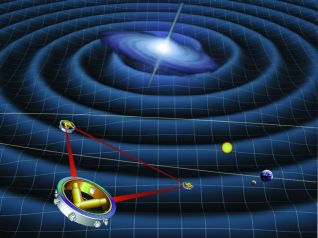Laser Interferometry Space Antenna (LISA)
LISA and the Gravitational Waves.
Contact S. Aston

The LISA (Laser Interferometry Space Antenna) mission will open up a new window on the universe by enabling the observation of low frequency gravitational waves. It can be expected to have an impact as significant as the development of infra-red or X-ray astronomy. LISA is a joint ESA-NASA mission that involves having three spacecraft flying approximately 5 million kilometres apart in an equilateral triangle formation. Together, they act as a Michelson interferometer to measure the distortion of space caused by passing gravitational waves.
The mission goal of LISA is to detect and observe gravitational waves from massive black holes and galactic binaries with periods in the range of a few seconds to a few hours (i.e. 10-4 to 10-1 Hz). Ground based interferometers, such as LIGO, find this range inaccessible due to the background of local gravitational noise arising from atmospheric effects and seismic activity. Ground-based interferometers are also physically limited in length to a few kilometres, restricting their coverage to events such as supernova core collapses and binary neutron star mergers.
LISA Pathfinder (SMART-2)
The entire LISA system is a device for measurement of changes in the lengths of the interferometer arms by observation of the phase of laser light passed between the spacecraft. The Phase Measurement System can therefore be considered as one of the keys to achieving the required mission performance.
A contract to assess the feasibility of producing a phase measurement system has been undertaken by the University of Birmingham in collaboration with industrial partners SEA. The objectives of the contract are focussed on understanding the Phase Measurement System for LISA by means of software tools, identifying the critical components needed to achieve the performance requirements, and justifying the technical solutions proposed by a combination of laboratory testing and preparations for in-orbit testing on SMART-2 (The Small Missions for Advanced Research in Technology). SMART-2 will test the technology needed to develop the ambitious ESA mission LISA.
The current status of the project is that the prototype SMART-2 Phase Measurement System has been delivered to the University of Glasgow, for further optical bench testing. The images available below show the fully populated phasemeter electronics board and some early results from testing.